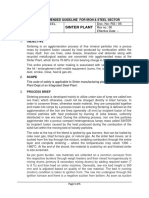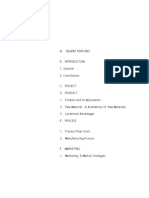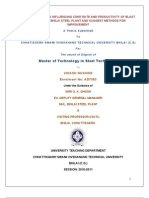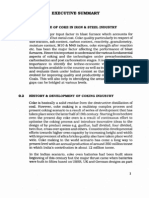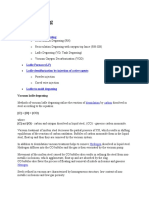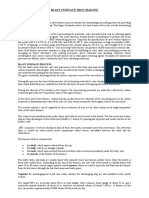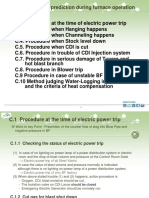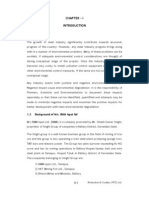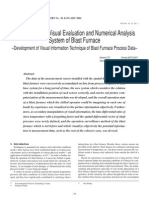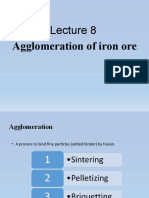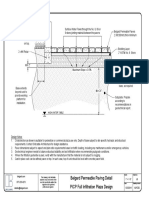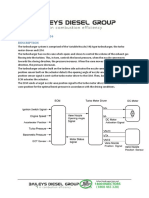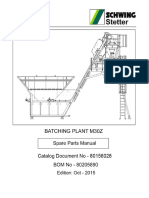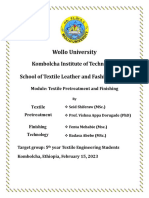Sintering of Iron Ore
➢ What is sintering: - Sintering is a process where iron ore fines are heated to high
temperature to partially fused and form strong agglomeration mass or iron ore.
Mainly to retain hematite in the final product.
➢ Charge mix: - Iron ore fines – 0.15mm to 5mm, coke breeze 4-8%, water-5-20%,
limestone. Coke breezes help to ignite the charge bed,
Not less than 0.15mm – else iron ore loss will be more due to hot air blow from the
top of the charge bed.
�➢ Fire line – red line just before the end of sinter breaker. Refer below picture (Bellow
1 to 23)
➢ Brek through point (BTP-red round) – End of redline where the temperature is
maximum, 13000C which is combustion zone (Bellow 24). Reaching the BTP is very
important because before BTP means sintered not completed and after the BTP
means phase transformation can occurred.
➢ Matching phenomenon: - Rate of preheating = rate of velocity of fire line. Sintering
temperature above 10000C is good formation of sintered product.
➢ Sintering Minerology: -
�➢ Acid sinter: – No CaO to be added, silicate bonds will occur, higher temperature
required to make it liquid, more fuel rate means need to add more C to melt silicate
and formation of bonding. By adding more C means hematite will converted to
magnetite and partially wustite as well. Hematite is better reductant/reducible in BF
than magnetite due to phase change HCP to FCC. Due to volume change it generates
lot of stress and porosity by introducing gases.
➢ Basic Sinter: - By adding CaO glass will form and helps to make bonding. Glass needs
less temperature to melt those silicates. Carbon rate will reduce, and hematite will
retain into the sinter structure which remain reducible. Reducibility increases but
strength decreases by increasing basicity. Strength become minimum and the fuel
rate will decrease. Strength will be minimum at Basicity 1.4. Phase transformation of
β to γ of di-calcium silicates during cooling results in volume expansion and become
fragile. Strength further increases beyond basicity at 1.6 because glass is
progressively replaced needle shaped crystalline calcium ferrite and makes strong
bond.
➢ There are four zones which are identified in the sinter bed height. These are given
below.
• Cold and wet zone – It includes the zone of the sinter bed with a temperature of less
than 1000C. This area is formed by the charge mix to be sintered, with upper limit
saturated in water/water vapour.
• Drying zone – It includes the sinter bed area with temperatures ranging between
1000C and 5000C. The evaporation of the sinter mix moisture and subsequent
dehydration of hydroxides take place in this zone.
• Reaction zone – It includes the zone of the sinter bed with a temperature ranging
between 5000C (coke ignition beginning) and 9000C (cooling period beginning). The
maximum temperature which reaches in this zone is in the range of 13000C to
14000C. The main processes which happen in this zone are (i) coke combustion
(exothermic), (ii) carbonates decomposition (endothermic), (iii) solid phase
reactions, (iv) reduction and re-oxidation of iron oxides, and (v) reactions of
formation of the sintered mass.
• Cooling zone – This zone is found immediately after the reaction zone. In this zone,
cooling and re-crystallization of the sintered product take place. There is a superficial
zone where the sinter layer is brittle than in the rest of the sinter bed.
➢ The following are the important issues related to sinter and sinter plants -
• Use of sinter reduces the coke rate and enhances the productivity in blast furnace.
• Sintering process helps utilization of iron ore fines (0-10 mm) generated during iron
ore mining operations.
• Sintering process helps in recycling all the iron, fuel and flux bearing waste materials
in the steel plant.
• Sintering process utilizes by product gases of the steel plant.
� • Sinter cannot be stored for a long time as it generates excessive fines during long
storages.
• Sinter generates excessive fines/dust during multiple handling in the sinter plant.
#SteelTalk#












